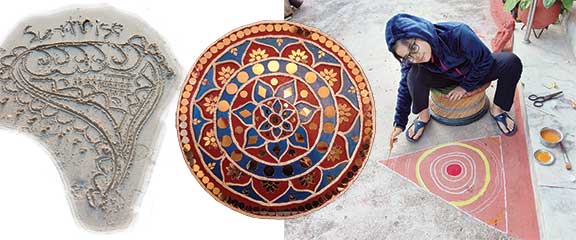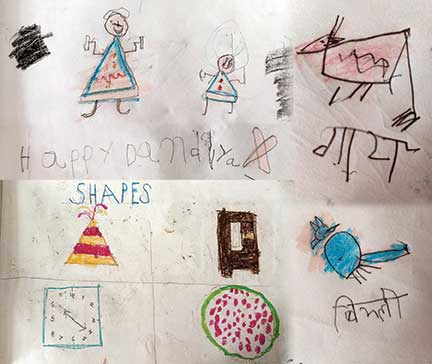Richa Goswami

On a sleepless night, while browsing on LinkedIn, I spent a good long time watching a hand create beautiful, almost 3D renditions of village life, bridge on a river, a fish, and so on. The artist in the same video also drew simple drawings of flamingo, rabbits, teddy bear, and other animals starting from digits. This made me wonder how these days a lot of videos on various platforms – YouTube, Instagram, and others – centre on drawing, sketching, or creation of interesting art and craft work. I am aware that my feed is filled with these recommendations because the algorithm now knows that I pause at such videos. But then there are other tell-tale signs signalling an increase in interest around craft creation.
• There has been an upward trend in the availability of colouring books for adults in the market. I remember reading that the sales of these books were a major contributing factor in the increase of sales of physical books. Psychiatrists believe that these books were emerging as a self-help or relaxation tool in times where there is an increase in mental stress due to a variety of factors and too much engagement with computer or mobile screens.
• The other common trend is increase in art and craft supply shops in malls. The DIY kits appropriate for 0-99, 5-99 or 8-99 age groups. The messaging is clear: age is no bar for engaging in creative work. This is how it should be.
The question that then begs our attention is how come an activity which is considered so important for adults is so ignored or considered useless in childhood. School timetables often give us an idea as to what is being prioritized. Most of the small or low-fee private schools do not have any time for arts (painting, dance, singing, etc.) in their timetable nor are there teachers available for these subjects. Most government primary schools keep art in the curriculum, but no work is done around it throughout the year. Schools for children coming from homes with limited resources usually focus their education on practical and utilitarian subjects. Subjects that enhance aesthetic or artistic expression are ignored. Any interest towards art awakens only when some event is to be celebrated in the school. In a way, 15th August and 26th January are perhaps the only reason why some semblance of art is still present in most such schools. The situation is different in elite private or big government schools, where there are teachers for all subjects including arts like painting, singing, dance, theatre, etc., and there are periods allocated on a regular basis.

In a society where the kind of school a child will attend is sealed at the time of birth based on the socioeconomic status of her parents, such differences in provisioning and prioritizing is a reflection on what is considered worth teaching1 to whom. This article reflects on how art education has always been part of cultural capital (Nash, 1990)2 of a small section of the society and what efforts one sees in the current times, to further this phenomenon.
Literature often gives a good description of what the norm at any given point of time was. Stories written about privileged families show how arts education (formal or informal) was a part of growing up for many. When we read the novels by Rabindranath Tagore like The Home and the World or the novels of Jane Austen, we find that a significant chunk of education in privileged families focused on art education. This is especially visible in women’s education. In the English novels, written during earlier times, the education of children from aristocratic families seems to be based on art education after learning to read and write. Be it learning to play the piano or painting or appreciating literature.
Bourdieu’s concept of cultural capital offers a good lens to make sense of this. Cultural capital comprises of knowledge, behaviours, and skills that a person can tap into to demonstrate one’s cultural competence and social status. Here we are talking about all those dimensions which the upper-class parents have always given to their children, and which establish their being a member of the upper class, such as language, values, behaviours, aesthetic appreciation, etc.
On the one hand, these are dimensions that establish or demonstrate membership to an upper class. On the other hand, membership to the class also leads to relationships that further become a means of economic progress. For both of these reasons, the middle classes make time and financial investment in such activities during the upbringing of their children. Aspects that form cultural capital, like knowledge of English was at one point of time, become aspirations for middle classes and they make investments to acquire them. These dimensions of art education help us understand how, for the upper and middle classes, it emerges as factors in selection of a school. It further explains a growing trend of evening classes for drawing, painting, Indian or western classical music, etc.
It is an irony that when it comes to making the teaching-learning process interesting, especially in primary classes, art classes continue to remain drab even though an attempt is being made to include painting, singing, and dancing with subject pedagogy. You must be familiar with such art classes, or may have participated in some, where painting means copying from a board or a book, being completely silent in a singing class and having your back to the wall in a dance class. It is also not common that dance or music classes practice exclusion where a few perform and most others sit and watch.
Seeing this lack of interest with respect to art in school education especially in the context of mass education, and misunderstanding regarding the importance of art education, NCF 2005 advocated devoting all possible resources and energy to promote art-related awareness and interest among children.

The textbooks developed post NCF 2005, especially for primary classes, included good examples of art in different forms. This also led to inclusion of art in the classroom. Many teachers were seen giving children some activities and painting opportunities, encouraging different forms of expression and not just being limited to words, to teach through art or to make their lessons interesting. But all of this was not entirely successful in implementing art education in its full spirit. Looking at the status of art education in school education, NEP 2020 strongly advocates the inclusion of art in the curriculum, considering art and culture as the basis of learning all other subjects.
NCF 2023 (draft) emphasizes arts being an important part of school education. NEP 2020 also seeks to make arts an integral part of the curriculum to ensure all-round development of students.
Just as the purpose of teaching mathematics is not to prepare mathematicians, but to mathematize the thought process of children, according to Nandlal Bose, the aim of art education is not to create an artist, but its aim should be to develop a sense of aesthetics and artistic behaviour in an individual. For this reason, Nandlal Bose emphasizes on giving equal importance to art education in schools as other subjects. His argument is that if an educated person’s conceptual understanding along with his sensibility also develops, then he gets the right artistic expression, which leads to all-round development of the personality.
NCF 2005 underlines that neglect of art education for many years has led to a kind of apathy towards understanding of art not only among children but also among parents, teachers, policy makers and even educationists. In the school environment, art is seen only as a ‘useful hobby’ or ‘recreational activity’. Even this limited exposure is available solely to children from privileged sections of society and as a whole the society remains artistically impoverished.
References
- Krishna Kumar (2009). What is worth teaching?
- Nash, R. (1990). Bourdieu on Education and Social and Cultural Reproduction. British Journal of Sociology of Education. (Vol. 11, No. 4), 431-447.
The author is the cofounder and director of Anweshak Sathi, a centre which supports NGOs and other organisations working in the education sector. As ensures that interventions working towards quality education are well designed, take research insights into consideration and are focused on learning from their own ground work. Her PhD research work was focused on Parental perceptions of quality education. She can be reached at goswami84@gmail.com.
Related Articles
What art gives to the curriculum
Arts equalize, not divide. Arts are freeing, not restrictive
